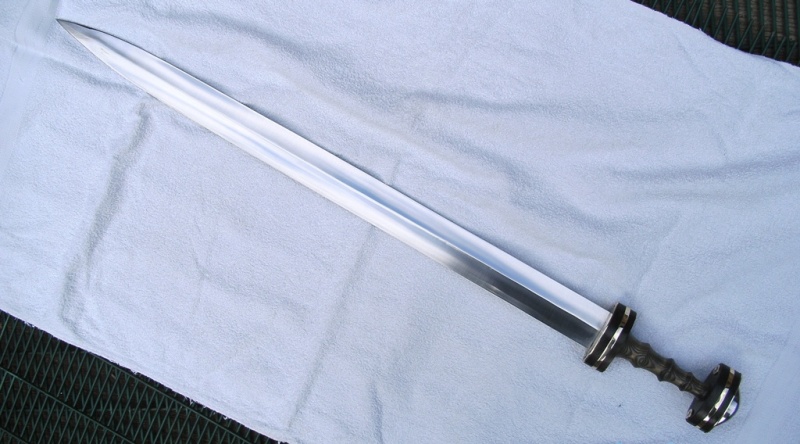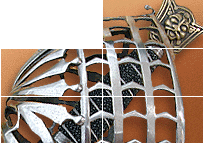
| myArmoury.com is now completely member-supported. Please contribute to our efforts with a donation. Your donations will go towards updating our site, modernizing it, and keeping it viable long-term.
Last 10 Donors: Graham Shearlaw, Anonymous, Daniel Sullivan, Chad Arnow, Jonathan Dean, M. Oroszlany, Sam Arwas, Barry C. Hutchins, Dan Kary, Oskar Gessler (View All Donors) |
| Author |
Message |
|
J. Dawes
Industry Professional
|
 Posted: Wed 18 Apr, 2012 2:51 am Post subject: Spatha 4th/5th C by White Well Arms Posted: Wed 18 Apr, 2012 2:51 am Post subject: Spatha 4th/5th C by White Well Arms |
 |
|
Here is a recently finished project.
Commissioned to me a few months ago.
Blade length: 74cm / 29 1/8 inch approx
Blade width: 4.6cm / 1 3/4 inch approx
Overall length: 89cm / 35.5inch approx
Weight: 1.9 pound
Blade of Hardened and Tempered Chromium, Vanadium .8 Carbon Steel. Hollow ground diamond section, semi sharp.
Hilt of Ash and Mahogany. Brass banding and fixings, with a steel cap and hot piened to ensure its sturdyness whilst being used.
A light and agile sword, which is exactly what i was after for horse back work.
Thanks for viewing.
 Attachment: 87.7 KB Attachment: 87.7 KB

 Attachment: 168.2 KB Attachment: 168.2 KB

 Attachment: 205.73 KB Attachment: 205.73 KB
[ Download ]
|
|
   |
 |
Paul Hansen

|
 Posted: Wed 18 Apr, 2012 3:41 am Post subject: Posted: Wed 18 Apr, 2012 3:41 am Post subject: |
 |
|
Looks like a well made and attractive sword!
I am wondering about the cross-section of the blade though, as I was under the impression that a lenticular blade, possibly with one or more fullers would have been the norm.
I also wonder a bit about the size of the metal pommel.
Which historical blade(s) did you use as an example / inspiration?
|
|
  |
 |
|
J. Dawes
Industry Professional
|
 Posted: Wed 18 Apr, 2012 4:38 am Post subject: Posted: Wed 18 Apr, 2012 4:38 am Post subject: |
 |
|
You are quite correct regarding the 3 fullers in the top 3rd of the blade.
Due to budget of the customer these were not added.
Regarding the metal cap, the original is wood. I wanted and confirmed with the customer that I prefer to hot pein all of my 'useable' swords as this is the strongest and most reliant method of securing a swords components.
If a customer required a brass locking nut I would happily have used this method.
Being confident that peining is stronger than a brass locking nut in effect. I wouldnt have been able to hot pien if the end cap was wood, therefore a much more hardwaring sword is made using this method. In my opinion anyway.
All in all I am confident that the sword is much less likely to come 'undone' during roman cabbage cutting displays and interpretations.
thanks for your feedback Paul.
Josef.
|
|
   |
 |
|
Patrick Kelly
|
 Posted: Wed 18 Apr, 2012 10:41 am Post subject: Posted: Wed 18 Apr, 2012 10:41 am Post subject: |
 |
|
That's a very sexy sword. It almost has a modernistic art deco look to it, very nice.
"In valor there is hope.".................. Tacitus
|
|
   |
 |
|
|
You cannot post new topics in this forum
You cannot reply to topics in this forum
You cannot edit your posts in this forum
You cannot delete your posts in this forum
You cannot vote in polls in this forum
You cannot attach files in this forum
You can download files in this forum
|
All contents © Copyright 2003-2025 myArmoury.com — All rights reserved
Discussion forums powered by phpBB © The phpBB Group
Switch to the Basic Low-bandwidth Version of the forum
|

